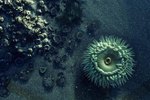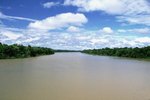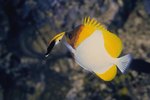
Often called one of the most dynamic and productive ecosystems on the planet, the cold water kelp forests are unique in structure and vitality. These densely populated oceanic plant beds are lush with a family of abrasive brown seaweeds, bearing leaf-like structures. An ideal underwater sanctuary, the oceanic kelp forest is teeming with life including fish, invertebrates, anemones, sea stars, urchins and a host of other underwater occupants.
Kelp Forest Fish
The number of fish that are found in the kelp forest is large, but some are more common than others. The kelp forest biome is home to more than 100 species of rockfish. Considered the most prolific fish species in the kelp forest, rockfish come in a variety of colors, shapes and sizes. The leopard shark, part-time resident of the kelp forest, is a sleek spotted animal and is one of the smallest sharks in the sea. A fan favorite of aquarists, and frequent denizen of the kelp forest, is the bright orange Garibaldi. Divers regale the Garibaldi's radiant appearance, even when surrounded by the black and gray regime of the lower kelp trophic areas. Another abundant fish in this watery garden is the kelp bass. A cooperative hunter, kelp bass travel in schools seeking sustenance on all levels of the kelp forest. Other fish residing in the kelp forest include cabezon, California sheepshead, giant kelp fish, horned shark and senorita fish.
The Circle of Life
The term "trophic process" describes exactly how the kelp forests function as a vital underwater ecosystem. Case studies of the kelp forest explain the relationship between living marine organisms and their nutritional network. This corporate cooperative support system is called the trophic process. As an example, the excretion of the predator fish at higher trophic levels becomes fertilizer for the seafloor substrate of kelp beds. This high concentration of beneficial nutrition promotes flourishing kelp, and subsequently provides nourishment and a safe haven for herbivores. These herbivores sustain predator fish, and the trophic process begins all over.
All in the Kelp Family
The word "kelp" pertains to marine algae belonging to the taxonomic order Laminariales. Kelp plants are diverse structurally, but require light and nutrients similar to common houseplants. Thanks to television and movies, the most recognizable species of kelp is the giant kelp (Macrocystis). Several other kelp genera exist including Laminaria, Alaria, Ecklonia, Lessonia and Eisenia, but in smaller beds. These plant-like algae anchor to the seafloor using an organic clamp called a haptera and prefer a rocky bottom. Under ideal conditions, giant kelp can grow 10 to 12 inches daily.
A Marine Forest Sanctuary
Kelp forests grow mostly off the Pacific Coast, from Alaska and Canada to the oceanic expanse off Baja California. Often compared to the terrestrial rain forests of the tropics, kelp forests form a canopy structure called surface mats, and maintain a strata situation below. Besides fish and other vertebrates prominent to kelp beds, thousands of invertebrates reside here including decapods, polychaetes, amphipods and ophiuroids. Many larger animals, such as grey whales, sun fish, sea lions and dolphins, use the kelp forest to forage or as a screen of protection against raging seas, swift currents and tumultuous tides.
References
Photo Credits
-
Jupiterimages/Photos.com/Getty Images




